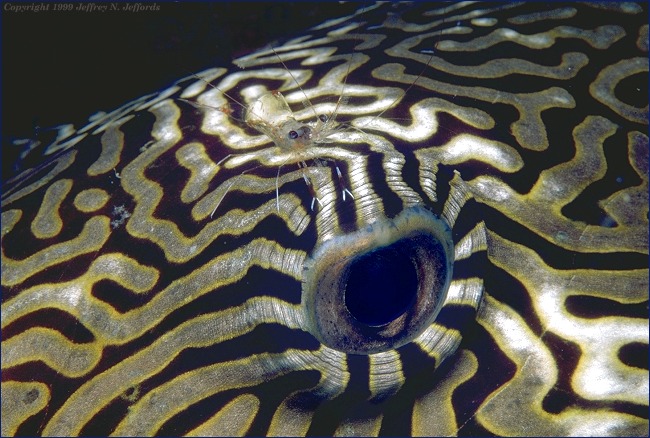 |
||||||||
There are at least 100 species of pufferfish, also commonly known as "blowfish", consisting of members of family Tertraodontidae. They are generally divided into two groups: the short-nosed puffers (family Terraodontinae, shown here) and the long-nosed puffers (family Canthigasterinae). This particular species of puffer, called a "map puffer", has a reticulated pattern on its body with dark lines radiating from the eye. It is quite large, with a length of over 14 inches. A small, transparent shrimp of the Periclimenes genus probably gets its meals from fish parasites or leftover morsels of food. Most species of pufferfish are only a few inches in length. The name refers to their ability to "puff up" by gulping water and inflating their bodies to around twice their normal size when threatened. The exaggerated size helps to discourage an attacking predator. Divers sometime amuse themselves by chasing after pufferfish, forcing them to inflate themselves defensively. Once inflated, the fishes' swimming speed is at least cut in half, and its ability to maneuver is limited by its relatively small fins. Divers are well-advised not to place fingers in the mouth of these fish-- though not aggressive, their jaws are very powerful and made for smashing sea urchins and other echinoderm prey. Pufferfish are frequently confused by name with a similar fish in the same order which also has an ability to inflate itself, called a porcupinefish. Pufferfish have a prickly texture when inflated, though they do not possess the large, rigid spines of the similar-looking porcupinefish. The porcupinefish number about 20 species with long, sharp spines which point outward when fully inflated. Their teeth are also slightly different, forming more of a sharp beak than the pufferfish. Pufferfish are prepared as meals for some. Called "fugu", this carefully prepared dish is named after one of the numerous species from the Fugu genus among which is Fugu rubripes. As with many fish that look "unconventional" these fish have toxic flesh. Many parts are especially concentrated in toxicity, such as the liver or ovaries. Puffer toxin blocks sodium channels in nerve tissues, ultimately paralyzing muscles and causing respiratory arrest; in fact, it is up to 1250 times deadlier than cyanide*. However, if prepared properly by specially trained chefs, certain parts of the fish may be consumed to produce a temporary narcotic effect. Many persons die every year by eating improperly prepared fugu; proper skill is essential as thorough expertise is required. Preparing a meal of fugu is not an option for the home chef. The preparation and consumption of pufferfish for these purposes is very popular in Japan, with many restaurants devoted entirely to the creation of various expensive, exotic dishes composed of fugu. The pufferfish Fugu rubripes is currently playing a significant role in the current quest to map the human genome. Fugu rubripes has the smallest genome of any vertebrate. Its genome is one-eighth the size of its human counterpart, yet bears marked resemblance in its structure. The genome of the pufferfish has about the same number of genes as humans, but lacks much of the filler "junk DNA" of the human genome. Comparisons allow geneticists to pinpoint the function of certain human genes. For more information, visit the U.S. Department of Energy's Joint Genome Institute. Above Pufferfish Identification: Map puffer, Arothron mappa (special thanks to Bart H. for assistance in identification)
* indicates more than one photo
|


![sharp-nose pufferfish [50k]](puffer_sharpnose_sample.gif)
![Blue-spotted pufferfish [152k]](puffer_bluespot_sample.gif)
